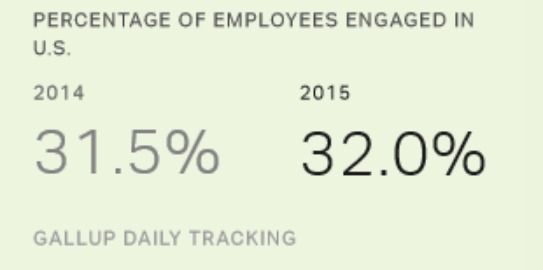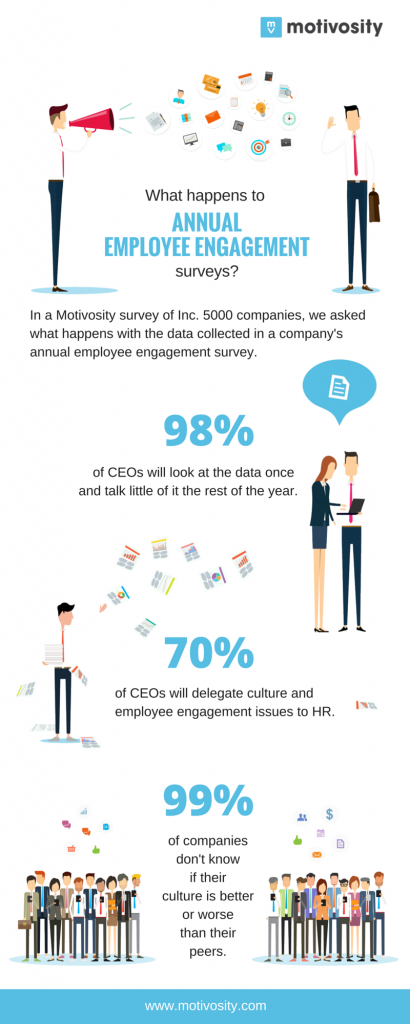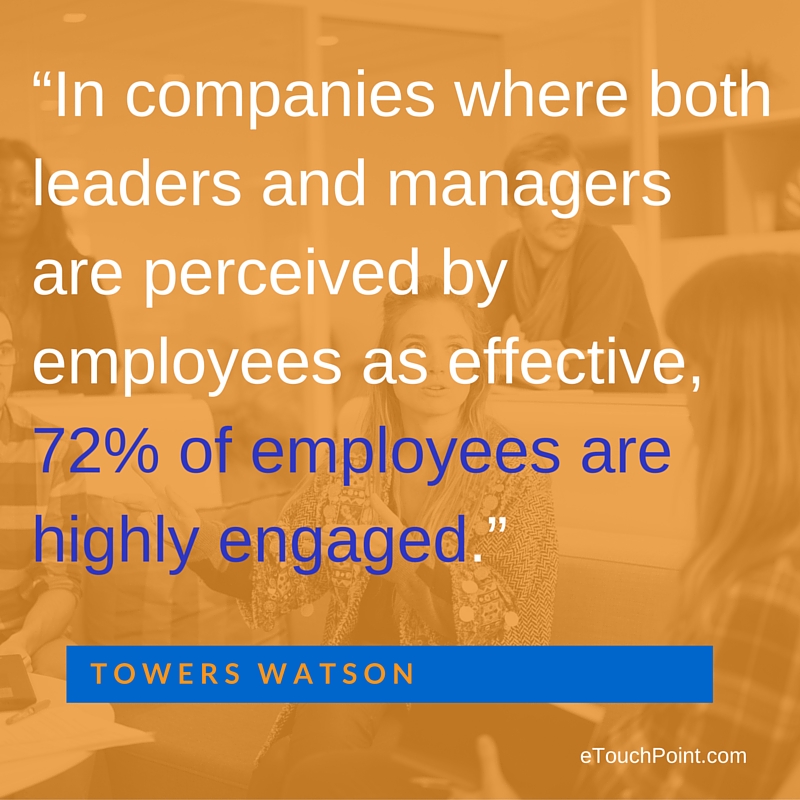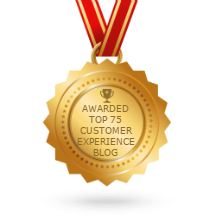Being part of a great team.
Offering a high-quality product or service.
Working for an inspirational visionary.
These and other qualities can motivate employees to become deeply engaged in their jobs and offer standout service to customers. In the past, many companies considered these factors to be “nice to have” in their environment, but not connected to the all-important bottom line.
Today’s organizations have a very different view. Many know that employee engagement is crucial to delivering strong, consistent, high-quality customer experiences (CX).
And, as insight from Bain & Company validates, employee engagement ties directly to financial results. Over a seven-year study period, organizations with highly engaged workforces experienced double the revenue growth of those with lower engagement levels.
But employee engagement in the U.S. is not where it should be.
In fact, research from Gallup shows that the percentage of employees who are engaged at work has hovered around 30% and remained flat since 2000:
Source: Gallup, 2016
What can companies do about this obvious disconnect?
Identifying and Measuring Employee Engagement
As CX guru Shep Hyken explained in a recent Forbes article, customers recognized engaged employees as the ones who “go the extra mile.”
Hyken describes a motivated employee as:
“…the person who goes out of his or her way or does something that is less than convenient without having to be asked.”
Of course, that behavior is obvious from the outside in—from the customer’s view. But what measures can an organization use to gauge engagement, among their workforce as a whole or for individual employees?
According to the Society for Human Resource Management (SHRM), employers traditionally evaluate 10 areas related to employee engagement in workforce surveys:
- Pride in employer
- Satisfaction with employer
- Job satisfaction
- Opportunity to perform well at challenging work
- Recognition and positive feedback for one’s contributions
- Personal support from one’s supervisor
- Effort above and beyond the minimum
- Understanding the link between one’s job and the organization’s mission
- Prospects for future growth with one’s employer
- Intention to stay with one’s employer
While these themes are useful to know, organizations must create a communications loop between leaders and employees to create an engaged culture.
Internal surveys are helpful in this process, but there’s more organizations can do. According to HRZone’s 2014 report, “The State of Employee Engagement,” more than half of organizations rely on annual employee surveys to gather feedback:
Source: HRZone, 2014
And a 2015 employee engagement study by Motvosity revealed that some leaders have a “collect it and forget it” attitude about employee feedback:
Source: Motivosity, 2016
Less than 2% of CEOs look at employee survey insights more than one time per year. And most delegate the important work of culture development to HR.
This hands-off approach is unlikely to foster the “go the extra mile” attitude that wins and wows customers.
Deepening Employee Engagement
Clearly, employee engagement practices are lacking for some companies. While there are no quick fixes, here are three proven ways to build a more engaged workforce.
- Involve leaders in creating an engagement culture
Engagement starts at the top. Today’s leaders must focus on creating a meaningful mission and clear values—and articulating these important guiding principles to employees.
As research from Modern Survey showed, employees who say their organization’s values are “known and understood” are 51% more likely to be highly engaged at work. That study also found “belief in senior leadership” to be the #1 driver of employee engagement.
Insight from Towers Watson underscores the importance of quality leadership.
Without question, engagement must start at the top and permeate every corner of an organization.
- Choose the right incentives for customer-centric teams
Many organizations have metrics that define the success of their customer-facing teams. And, historically, these metrics often focus on financials—such as revenues or numbers of items sold per customer.
As Joe Sejan pointed out in a recent blog post, financial metrics can often motivate the wrong behaviors in front-line employees—and lead to lower-quality customer experiences. He explains:
“What happens when people are asked to achieve figures in order to get their incentive?
They see customers as numbers, not human beings. So they focus on one thing: hitting their numbers to get their monthly incentive. In this dynamic, delivering an experience becomes secondary.”
To fix this common problem, brands can shift their front-line metrics. Employees should receive rewards and praise based on customer feedback—and on activities, such as training, they complete to improve their brand knowledge and customer empathy.
- Use technology to streamline performance recognition
Today’s companies can rely on advanced technology to convey positive customer sentiments to front-line employees and managers. Leading CX systems can create triggered alerts that automatically deliver very positive customer feedback to managers for review. Using that insight, managers can celebrate successes—by alerting leaders, commending employees, or sharing good news with their teams.
A Real-World Example of the Power of Customer Feedback
At eTouchPoint, we have worked side-by-side with Fortune 100 innovators who are exploring new ways to cultivate employee engagement.
One of our clients has used voice of the customer (VoC) feedback to revolutionize the performance of its front-line field service team, more than 10,000 strong. The organization has created exceptional performance alerts to highlight customer praise.
Whenever a customer leaves VoC feedback noting outstanding employee performance, mangers receive alerts in near-real time. After reviewing the customer’s feedback, managers can create recognition letters, endorsed by a VP. Typically, there are 10 to 15 commendation letters each month—out of hundreds of thousands of interactions. They are highly coveted by employees.
In addition, the organization also creates “spotlight alerts” that go out to a broader audience. These communications recognize patterns of strong performance and commend top performers. The result: a sense of healthy internal competition and motivation to “go the extra mile.”
The organization still uses other CX and operational metrics to gauge performance—and understand opportunities for additional training or performance enhancements. But, as one of the company’s operational leads describes, authentic customer input has the greatest impact on employee motivation:
“You can come up with a lot of different metrics to measure the success of an employee, but I think giving comments and what a customer thinks carries a lot more credence than numbers.”
Everyone Wins in an Engaged Culture
In the past, executives’ mandate to achieve financial performance and employee’s desire to make a meaningful contribution seemed like polar opposite aims. Fortunately, today’s organizations know better.
Still, most companies have work to do to move from knowing they should build an engagement culture to creating one.
Using customer feedback to motivate front-line teams in a key asset in this journey. By using customers’ own words, organizations can help employees see customers as people, not numbers. Customers appreciate being treated with respect for their individual needs. Employees can see how their actions and words touch people’s lives.
And, for many employees, that is exactly what makes work meaningful.
Author: Connie Harrington
Connie is a content strategist and serves as managing editor of the eTouchPoint blog. Possessing 15+ years of international experience across five continents, her focus areas include: customer experience management, customer contact management, communications planning, content marketing, email marketing, and employee engagement. Previously, she held marketing and communications leadership positions at CGI, Mindwrap, and TEOCO. She earned a B.A., cum laude, from the College of William and Mary in Virginia.






